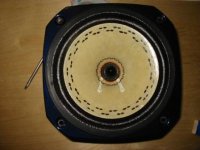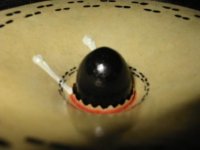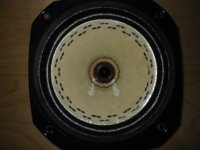Re: CSD comparisons..
Everyone to their own... it does seem that more & more people are finding that what a FR does right, outweighs what it doesn't do so well (and with that surge in popularity more people are working to make the not so wells go away)
dave
auplater said:That's why I don't much care for the "full range" approach.. at least not using cone drivers...
Everyone to their own... it does seem that more & more people are finding that what a FR does right, outweighs what it doesn't do so well (and with that surge in popularity more people are working to make the not so wells go away)
dave
when one can get a driver (albeit a tweeter) for ~$19 that looks alot better (w/o EnABL no less) ...
I'm contemplating that idea but I'm not sure what the trade-off will be. Adding a tweeter would also mean adding a crossover which will surely affect the phase resonse.
During my distortion tests I discovered something: the 2nd harmonic distortion of the amp and the driver in part cancel each other out. The distortion measured in room is less than on the output of the amp. I'm afraid this will not be the case if there is a passive crossover in place (have to test that somehow).
what a FR does right, outweighs what it doesn't do so well
Exactly my point. This is why I do all this experimenting, to find out what it is that a FR does right.
Gerrit Boers said:
I'm contemplating that idea but I'm not sure what the trade-off will be. Adding a tweeter would also mean adding a crossover which will surely affect the phase resonse.
During my distortion tests I discovered something: the 2nd harmonic distortion of the amp and the driver in part cancel each other out. The distortion measured in room is less than on the output of the amp. I'm afraid this will not be the case if there is a passive crossover in place (have to test that somehow).
Exactly my point. This is why I do all this experimenting, to find out what it is that a FR does right.
Not sure how the 2nd order distortions "cancel out" thruout the room and measurement domain (contrary to std. error summation theory) but it's great if they do.
One reason I've gone with planars is that, for the money I've spent, they sound better than cones at anywhere near what I paid, they don't require an array (I've gone with the big planars) and the cabinets are alot simpler (open baffles for mids and highs)
I'm not anti "full range" by any means, Dave... just prefer the planar approach over cones... not tied to high sensitivity drivers (although my RD75/Neoplanars are probably 92 dB or so efficient.
I wish I could find a lf planar driver of comaparble quality, size, and cost... probably doesn't exist
BTW, Gerrit, I like what you're doing with EHR... I run my wifes medical practice and we're grappling with the whole EHR/EMR issue vs. cost vs. payoff. Thusfar, can't see much advantage over how we're doing things now, and BIG penalty from the financial side.
John L.
Not sure how the 2nd order distortions "cancel out" thruout the room and measurement domain (contrary to std. error summation theory) but it's great if they do.
I just put up a page with some interesting results . It's the old solid state vs. set debate in a new light.
RD75/Neoplanars are probably 92 dB or so efficient
Alas, not enough for use with a 300B amp.
BTW, Gerrit, I like what you're doing with EHR... I run my wifes medical practice and we're grappling with the whole EHR/EMR issue vs. cost vs. payoff. Thusfar, can't see much advantage over how we're doing things now, and BIG penalty from the financial side.
Thanks.
IMHO there is not much value in using IT in a single practice. Things become interesting when there is communication between GPs, pharmacies and hospitals. That's what were currently working on in The Netherlands.
very interesting. i have seen this kind of thing mentioned before but only seen results when similar has been applied to driver & output stages.
It furthrt solidifird the noyion that a speaker or amp has to be considered a system with its partnering amp or speaker.
dave
It furthrt solidifird the noyion that a speaker or amp has to be considered a system with its partnering amp or speaker.
dave
auplater said:[
I'm not anti "full range" by any means, Dave... just prefer the planar approach over cones... not tied to high sensitivity drivers (although my RD75/Neoplanars are probably 92 dB or so efficient.
Big planars was where i started... the realization that when coupled with a small tube amp, the comes were overall more enjoyable than the big panels with their required amplification i got onto exploring traditional FRs... its all about the music and i found i was listening & enjoying more.
dave
Giving the enable thing a go. First attempt, my printer is acting up so no pattern to follow. I used my finger as a guide (used to pinstripe) to draw the concentric circles and a protractor to get the spacing. There is a light layer of dammar on the cone giving it that gloss. The driver is a FE-166esr.
Attachments
here's a shot of 'teeth' I cut (mostly on a hunch). I wanted to cut a quadratic pattern for dispersion or remove the lip entirely. I was too lazy for the quadratic pattern and didn't want to mess with the VC wires to remove the lip entirely... I know if I started I'd get carried away and try to shape the lip for smooth flow and have to relocate the entry of the wires... on most other drivers sure, but I have a sentimental attachment to these.
Oh! point. At first go sans whizzer I heard sort of sibilant edge that bugged me. I felt a little ticked off and the tooth pattern was the first and successful attempt. The sibilance went away and more clarity came forward. Happy camper.
Edit: I need to lessen the gap between vc and phase plugs, the picture enhances the effect.
Oh! point. At first go sans whizzer I heard sort of sibilant edge that bugged me. I felt a little ticked off and the tooth pattern was the first and successful attempt. The sibilance went away and more clarity came forward. Happy camper.
Edit: I need to lessen the gap between vc and phase plugs, the picture enhances the effect.
Attachments
Illusus said:I need to lessen the gap between vc and phase plugs
Maybe a bit longer to. And EnABL them
dave
Bartek G.
You will want to be careful to watch for marauding timber wolves from the western mountains, after flaunting that bit of work! After the spots leave Dave's eyes and he can actually see you, of course....
Nice work for a veteran striper. Don't hesitate to spot up the rest of your home... a fellow on Oahu was eying his window glass the last time I communicated with him.
If you apply a light coat of Micro Scale Gloss, over the entire thing including those teeth, it will tend to draw an even finer focus on the really tiny sounds.
See Dave's earlier posting pic's to discover how to make the phase plug play right along.
The teeth are a very good idea, by the way.
Bud
You will want to be careful to watch for marauding timber wolves from the western mountains, after flaunting that bit of work! After the spots leave Dave's eyes and he can actually see you, of course....
Nice work for a veteran striper. Don't hesitate to spot up the rest of your home... a fellow on Oahu was eying his window glass the last time I communicated with him.
If you apply a light coat of Micro Scale Gloss, over the entire thing including those teeth, it will tend to draw an even finer focus on the really tiny sounds.
See Dave's earlier posting pic's to discover how to make the phase plug play right along.
The teeth are a very good idea, by the way.
Bud
Dave, maybe I should just buy a pair from you if you have some on hand, lathe time at work isn't easy to come by these days, they keep me too busy for g-jobs.
BudP, thank you for the kind words. I'm not that good with the brushes anymore, I got a little case of shakes after a concussion, never went away.
I just may start patterning the place, I like the look.
Will the coat of dammar already present on the cone mess up the Micro Scale Gloss application and/or effect?
BudP, thank you for the kind words. I'm not that good with the brushes anymore, I got a little case of shakes after a concussion, never went away.
I just may start patterning the place, I like the look.
Will the coat of dammar already present on the cone mess up the Micro Scale Gloss application and/or effect?
Will the coat of dammar already present on the cone mess up the Micro Scale Gloss application and/or effect?
If the Dammar is under the pattern, no problem, put a single 50% cut with water gloss coat over the whole thing. If it is over the pattern I might just let things settle for a time and listen. If you then think something more is needed then, the Gloss would be a useful tool.
It will take you a while to reeducate your ears to be able to make any decisions about the Gloss, or the rest of your system for that matter.
Bud
Hello, since the first posts of this thread really confused me, may i ask, why do you paint your speaker cones? It looks kind of esotheric for me. Like C37 or expensive cables. Is there some theoretical base for all this, that can be explained in less than the whole threads length?
This link should give you what you need
http://www.positive-feedback.com/Issue21/standingwaves.htm
this includes Bud's US patent number for your reference (use Google Patents)
http://www.positive-feedback.com/Issue21/standingwaves.htm
this includes Bud's US patent number for your reference (use Google Patents)
The paint soaks into the paper and changes the stiffness so it helps break up some vibration modes. The patent explains it well.MaVo said:Hello, since the first posts of this thread really confused me, may i ask, why do you paint your speaker cones? It looks kind of esotheric for me. Like C37 or expensive cables. Is there some theoretical base for all this, that can be explained in less than the whole threads length?
A ressonance can travel over the cone, inwards ot outwards and when it comes to the surround or voice coil it gets chaotic or it might try to get in another direction
Look at the waves in the see and look at what happens when waves hit a mole ... its chaos with the waves moving up and down because they cant get away because of the new waves coming
It is possible that any type of material or zigzag pattern at these places may calm or suck up these chaotic ressonances
But I would also think that its very much driver related ... it may work better on light coned FR than on a big driver with a more heavy cone
Look at the waves in the see and look at what happens when waves hit a mole ... its chaos with the waves moving up and down because they cant get away because of the new waves coming
It is possible that any type of material or zigzag pattern at these places may calm or suck up these chaotic ressonances
But I would also think that its very much driver related ... it may work better on light coned FR than on a big driver with a more heavy cone
MaVo,
I paint the cones because it is the easiest and least expensive way to inhibit the energy that becomes non linear and exits the cone, or dome or other surface, outside of the information organization it entered the cone with.
I also paint them, with the small blocks, to provide a one way gate into and off of the cone. These two , together, force the energy to remain in the information organization, pass across the surface of the driver only once and create a uniform compression wave in the air.
The results are always startlingly clear and structurally correct sounds. Plus, the very small sounds, like the decay of a note in a piano's wooden chassis, is maintained in structure and with absolute clarity, regardless of what other information the driver is also providing.
The level of correction is on the scale of a change from a pretty good table radio to the live event, rather than from one cable to another. This is why I paint speakers
Tinitus,
Fortunately, the size of the driver is irrelevant. From hearing aid vibrator plates through ear bud headphones to ribbon tweeters and 24 inch woofers, the same effects are found. Elimination of spurious response due to reflection and refractions on the emitter surface. There is not a "gradient" of usefulness due to driver construction, but there is one driver did not need EnABL's help.
Bud
I paint the cones because it is the easiest and least expensive way to inhibit the energy that becomes non linear and exits the cone, or dome or other surface, outside of the information organization it entered the cone with.
I also paint them, with the small blocks, to provide a one way gate into and off of the cone. These two , together, force the energy to remain in the information organization, pass across the surface of the driver only once and create a uniform compression wave in the air.
The results are always startlingly clear and structurally correct sounds. Plus, the very small sounds, like the decay of a note in a piano's wooden chassis, is maintained in structure and with absolute clarity, regardless of what other information the driver is also providing.
The level of correction is on the scale of a change from a pretty good table radio to the live event, rather than from one cable to another. This is why I paint speakers
Tinitus,
Fortunately, the size of the driver is irrelevant. From hearing aid vibrator plates through ear bud headphones to ribbon tweeters and 24 inch woofers, the same effects are found. Elimination of spurious response due to reflection and refractions on the emitter surface. There is not a "gradient" of usefulness due to driver construction, but there is one driver did not need EnABL's help.
Bud
Live instruments???
Has anyone ever tried this process on a clarinet or trumpet bell?? Maybe make a cheap violin sound like a more expensive violin/guitar/drum, etc.???
John L.
Has anyone ever tried this process on a clarinet or trumpet bell?? Maybe make a cheap violin sound like a more expensive violin/guitar/drum, etc.???
John L.
- Status
- Not open for further replies.
- Home
- Loudspeakers
- Multi-Way
- EnABL Processes


